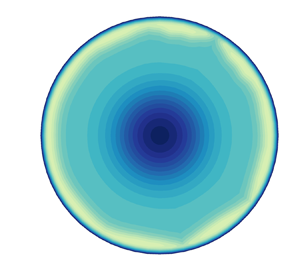Article contents
Instability and symmetry breaking of surfactant films over an air bubble
Published online by Cambridge University Press: 09 December 2022
Abstract

We examine the asymmetric flows of aqueous surfactant films over an air bubble. A thin film is formed by raising an equilibrated air bubble through an aqueous solution of Triton X-100 (0.01 mM, below critical micelle concentration). Due to the advection generated by the squeezing motion, the initially uniformly distributed surfactants redistribute and, thus, generate an axisymmetric surface tension gradient that drives a Marangoni flow. The external forcing of raising the bubble also creates an axisymmetric dimpled film with a radial thickness variation that reaches its minimum at the rim of the dimple. The curvature in the film thickness generates an axisymmetric capillary pressure driven flow. When the apex of the bubble has penetrated the initially flat air-solution interface, the rising bubble is stopped and the resulting flow demonstrates symmetry breaking both in the experiment and in the parameter matched numerical simulation. Linear stability analysis reveals the mechanism behind the disturbance growth. It is found that the most dangerous azimuthal wavenumber scales linearly with the ratio of the rim radius to the radial width of significant radial pressure and surface tension gradients after stopping the bubble. Finally, we compare this instability to the previously studied surfactant spreading induced fingering phenomenon (Warner, Craster & Matar, Phys. Fluids, vol. 16, issue 8, 2004, pp. 2933–2951).
JFM classification
- Type
- JFM Papers
- Information
- Copyright
- © The Author(s), 2022. Published by Cambridge University Press
References
REFERENCES
- 5
- Cited by



